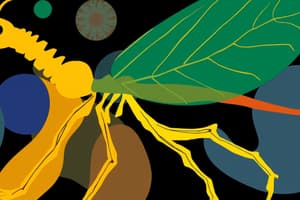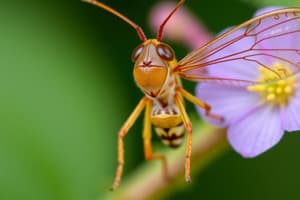Podcast
Questions and Answers
What is the science of naming and classifying organisms?
What is the science of naming and classifying organisms?
- Ecology
- Evolution
- Taxonomy (correct)
- Biodiversity
What is a group of organisms in a classification system called?
What is a group of organisms in a classification system called?
taxon
What is a system that gives each species a two-part scientific name using Latin words?
What is a system that gives each species a two-part scientific name using Latin words?
binomial nomenclature
What is one or more physically similar species that are thought to be closely related?
What is one or more physically similar species that are thought to be closely related?
What did Linnaeus develop regarding the classification and naming of organisms?
What did Linnaeus develop regarding the classification and naming of organisms?
What does taxonomy give scientists?
What does taxonomy give scientists?
On what basis does Linnaean taxonomy classify organisms?
On what basis does Linnaean taxonomy classify organisms?
How are organisms placed in the hierarchy of classification?
How are organisms placed in the hierarchy of classification?
What is the basic taxon in the Linnaean system?
What is the basic taxon in the Linnaean system?
What are species most commonly defined as in the Linnaean system?
What are species most commonly defined as in the Linnaean system?
What is the first part of the scientific name?
What is the first part of the scientific name?
What is an example of a genus?
What is an example of a genus?
How is a genus always written?
How is a genus always written?
What is the second part of the scientific name?
What is the second part of the scientific name?
What can a species descriptor refer to?
What can a species descriptor refer to?
How is a species descriptor always written?
How is a species descriptor always written?
What is an example of a species descriptor?
What is an example of a species descriptor?
What do scientific names allow scientists to talk about?
What do scientific names allow scientists to talk about?
What else do scientific names allow scientists around the world to do?
What else do scientific names allow scientists around the world to do?
How many levels does the Linnaean system of classification have?
How many levels does the Linnaean system of classification have?
What is another name for the levels of classification in the Linnaean system?
What is another name for the levels of classification in the Linnaean system?
What are the Linnaean system of classification levels (from highest to lowest)?
What are the Linnaean system of classification levels (from highest to lowest)?
What is Ms. Con's way to remember the Linnaean system of classification levels?
What is Ms. Con's way to remember the Linnaean system of classification levels?
How does the Linnaean system of classification work?
How does the Linnaean system of classification work?
What do the levels represent moving down the Linnaeus levels?
What do the levels represent moving down the Linnaeus levels?
How is the Linnaeus system of classification grouped?
How is the Linnaeus system of classification grouped?
What does Linnaeus' system of classification focus on?
What does Linnaeus' system of classification focus on?
What can unrelated species evolve similar traits through?
What can unrelated species evolve similar traits through?
Today, what do scientists use to help classify living things?
Today, what do scientists use to help classify living things?
Why are genetic similarities between two species more likely than physical similarities?
Why are genetic similarities between two species more likely than physical similarities?
Give an example of physical similarities in the Linnaeus system compared to today.
Give an example of physical similarities in the Linnaeus system compared to today.
When do members of different populations experience reproductive isolation?
When do members of different populations experience reproductive isolation?
Study Notes
Taxonomy
- Definition: The science of naming and classifying organisms.
- Provides a standardized way to refer to species, facilitating communication among scientists about living things.
Taxa and Classification
- Taxon: A group of organisms in a classification system.
- The hierarchy in the Linnaean system consists of 7 levels, with each level being nested within more general categories.
Binomial Nomenclature
- A system that assigns each species a two-part Latin scientific name, enhancing clarity and specificity.
- The first part represents the genus and is always capitalized and italicized; the second part, the species descriptor, is lowercase and also italicized.
Genus and Species
- Genus: A collection of physically similar species that are closely related, such as Quercus for oak trees.
- Species is the basic taxon in Linnaean classification and refers to organisms that can breed and produce fertile offspring.
Levels of Classification
- Linnaean classification levels, from highest to lowest: Kingdom, Phylum, Class, Order, Family, Genus, Species.
- Mnemonic to remember levels: "King Philip Came Over For Great Spaghetti."
Classification Focus and Evolution
- Linnaeus’ system emphasizes physical similarities for classification.
- Convergent evolution explains how unrelated species can develop similar traits.
- Genetic research is increasingly used to classify organisms, as it provides insights into evolutionary relationships more reliable than physical traits alone.
Reproductive Isolation and Speciation
- Reproductive isolation occurs when members of different populations can no longer mate successfully, leading to the emergence of new species.
Examples and Modern Classification
- Genetic similarities among species are often more accurate than physical similarities due to shared ancestry.
- For instance, the giant panda's classification based on physical traits initially placed it with raccoons, but genetic studies reveal it is more closely related to bears.
Studying That Suits You
Use AI to generate personalized quizzes and flashcards to suit your learning preferences.
Description
Dive into the essentials of taxonomy with this interactive flashcard quiz. Explore key terms such as taxon and binomial nomenclature, essential for understanding biological classification. Perfect for biology students looking to strengthen their knowledge of organism classification.




